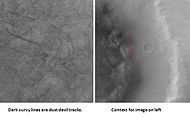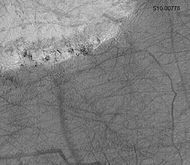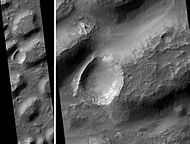Eridania quadrangle
 Map of Eridania quadrangle from Mars Orbiter Laser Altimeter (MOLA) data. The highest elevations are red and the lowest are blue. | |
| Coordinates | 47°30′S 210°00′W / 47.5°S 210°W / -47.5; -210Coordinates: 47°30′S 210°00′W / 47.5°S 210°W / -47.5; -210 |
|---|---|

Image of the Eridania Quadrangle (MC-29). The region mainly includes heavily cratered highlands. The west-central part includes Kepler Crater.
The Eridania quadrangle is one of a series of 30 quadrangle maps of Mars used by the United States Geological Survey (USGS) Astrogeology Research Program. The Eridania quadrangle is also referred to as MC-29 (Mars Chart-29).[1]
The Eridania quadrangle lies between 30° and 65° south latitude and 180° and 240° west longitude on the planet Mars. Most of the classic region named Terra Cimmeria is found within this quadrangle. Part of the Electris deposits, a 100–200 meters thick, light-toned deposit covers the Eridania quadrangle.[2] Many slopes in Eridania contain gullies, which are believed to be caused by flowing water.
Contents
1 Martian Gullies
2 Dust devil tracks
3 Paleomagnetism
4 Dunes
5 Glacial features
6 Lake
7 Craters
8 Latitude dependent mantle
9 Channels
10 Other features in Eridania quadrangle
11 Other Mars quadrangles
12 Interactive Mars map
13 See also
14 References
15 Further reading
16 External links
Martian Gullies
The Eridania quadrangle is the location of gullies that may be due to recent flowing water. Gullies occur on steep slopes, especially on the walls of craters. Gullies are believed to be relatively young because they have few, if any craters. Moreover, they lie on top of sand dunes which themselves are considered to be quite young. Usually, each gully has an alcove, channel, and apron. Some studies have found that gullies occur on slopes that face all directions,[3] others have found that the greater number of gullies are found on poleward facing slopes, especially from 30-44 S.[4][5]
Although many ideas have been put forward to explain them,[6] the most popular involve liquid water coming from an aquifer, from melting at the base of old glaciers, or from the melting of ice in the ground when the climate was warmer.[7][8] Because of the good possibility that liquid water was involved with their formation and that they could be very young, scientists are excited. Maybe the gullies are where we should go to find life.
There is evidence for all three theories. Most of the gully alcove heads occur at the same level, just as one would expect of an aquifer. Various measurements and calculations show that liquid water could exist in aquifers at the usual depths where gullies begin.[9] One variation of this model is that rising hot magma could have melted ice in the ground and caused water to flow in aquifers. Aquifers are layer that allow water to flow. They may consist of porous sandstone. The aquifer layer would be perched on top of another layer that prevents water from going down (in geological terms it would be called impermeable). Because water in an aquifer is prevented from going down, the only direction the trapped water can flow is horizontally. Eventually, water could flow out onto the surface when the aquifer reaches a break—like a crater wall. The resulting flow of water could erode the wall to create gullies.[10] Aquifers are quite common on Earth. A good example is "Weeping Rock" in Zion National Park Utah.[11]
As for the next theory, much of the surface of Mars is covered by a thick smooth mantle that is thought to be a mixture of ice and dust.[12][13][14] This ice-rich mantle, a few yards thick, smooths the land, but in places it has a bumpy texture, resembling the surface of a basketball. The mantle may be like a glacier and under certain conditions the ice that is mixed in the mantle could melt and flow down the slopes and make gullies.[15][16][17] Because there are few craters on this mantle, the mantle is relatively young. An excellent view of this mantle is shown below in the picture of the Ptolemaeus Crater Rim, as seen by HiRISE.[18]
The ice-rich mantle may be the result of climate changes.[19] Changes in Mars's orbit and tilt cause significant changes in the distribution of water ice from polar regions down to latitudes equivalent to Texas. During certain climate periods, water vapor leaves polar ice and enters the atmosphere. The water comes back to ground at lower latitudes as deposits of frost or snow mixed generously with dust. The atmosphere of Mars contains a great deal of fine dust particles. Water vapor will condense on the particles, then fall down to the ground due to the additional weight of the water coating. When Mars is at its greatest tilt or obliquity, up to 2 cm of ice could be removed from the summer ice cap and deposited at midlatitudes. This movement of water could last for several thousand years and create a snow layer of up to around 10 meters thick.[20][21] When ice at the top of the mantling layer goes back into the atmosphere, it leaves behind dust, which insulating the remaining ice.[22] Measurements of altitudes and slopes of gullies support the idea that snowpacks or glaciers are associated with gullies. Steeper slopes have more shade which would preserve snow.[4][5]
Higher elevations have far fewer gullies because ice would tend to sublimate more in the thin air of the higher altitude.[23]
The third theory might be possible since climate changes may be enough to simply allow ice in the ground to melt and thus form the gullies. During a warmer climate, the first few meters of ground could thaw and produce a "debris flow" similar to those on the dry and cold Greenland east coast.[24] Since the gullies occur on steep slopes only a small decrease of the shear strength of the soil particles is needed to begin the flow. Small amounts of liquid water from melted ground ice could be enough.[25][26] Calculations show that a third of a mm of runoff can be produced each day for 50 days of each Martian year, even under current conditions.[27]

Labeled gully, as seen by HiRISE under HiWish program

Gullies, Gullies, as seen by HiRISE under HiWish program

Gullies in a crater in Eridania, north of the large crater Kepler. Also, features that may be remains of old glaciers are present. One, to the right, has the shape of a tongue. Image taken with Mars Global Surveyor, under the MOC Public Targeting Program.

HiRISE image showing gullies. The scale bar is 500 meters. Picture taken under the HiWish program.

Gullies and layers in mantle on a wall, as seen by HiRISE under HiWish program

Gullies, as seen by HiRISE under HiWish program

Close-up of some gullies from previous image, as seen by HiRISE under HiWish program

Close-up of apron on one of the gullies from previous image. Image was taken by HiRISE, under the HiWish program

Gullies, as seen by HiRISE under HiWish program

Gullies on two different levels in crater, as seen by HiRISE under HiWish program

Wide view of gullies, as seen by HiRISE under HiWish program

Close view of gully from previous image, as seen by HiRISE under HiWish program

Wide view of gullies in a crater, as seen by HiRISE under HiWish program

Close view of gully from previous image, as seen by HiRISE under HiWish program

Close view of gully from a previous image, as seen by HiRISE under HiWish program Curved ridges may have formed by glaciers before the gullies were created.

Crater with gullies, as seen by HiRISE under HiWish program

Close view of gully apron showing erosion of the channels, as seen by HiRISE under HiWish program

Close view of gullies with small channels, as seen by HiRISE under HiWish program Arrow points to one small channel in a larger valley.

Crater with gullies, as seen by HiRISE under HiWish program

Crater with gullies, as seen by HiRISE under HiWish program

Gasa Crater, as seen by CTX Note: Gasa Crater is the smaller crater. It is believed the impact that created Gasa occurred in a debris-covered glacier.

Gullies in Gasa Crater, as seen by HiRISE.

Gullies in crater in Phaethontis quadrangle, as seen by HiRISE under HiWish program
Dust devil tracks
Many areas on Mars, including Eridania, experience the passage of giant dust devils. A thin coating of fine bright dust covers most of the Martian surface. When a dust devil goes by it blows away the coating and exposes the underlying dark surface.
Dust devils occur when the sun warms up the air near a flat, dry surface. The warm air then rises quickly through the cooler air and begins spinning while moving ahead. This spinning, moving cell may pick up dust and sand then leave behind a clean surface.[28]
Dust devils have been seen from the ground and high overhead from orbit. They have even blown the dust off of the solar panels of the two Rovers on Mars, thereby greatly extending their lives.[29] The twin Rovers were designed to last for 3 months, instead they lasted more than six years, and one is still going after 8 years. The pattern of the tracks have been shown to change every few months.[30]
A study that combined data from the High Resolution Stereo Camera (HRSC) and the Mars Orbiter Camera (MOC) found that some large dust devils on Mars have a diameter of 700 meters and last at least 26 minutes.[31]
Kepler (Martian crater) showing dust devil tracks, as seen by Mars Global Surveyor.
Pattern of large and small tracks made by giant dust devils as seen by Mars Global Surveyor, under the MOC Public Targeting Program. Location is 55.11 S and 196.63 W.
Paleomagnetism
The Mars Global Surveyor (MGS) discovered magnetic stripes in the crust of Mars, especially in the Phaethontis and Eridania quadrangles (Terra Cimmeria and Terra Sirenum).[32][33] The magnetometer on MGS discovered 100 km wide stripes of magnetized crust running roughly parallel for up to 2000 km. These stripes alternate in polarity with the north magnetic pole of one pointing up from the surface and the north magnetic pole of the next pointing down.[34] When similar stripes were discovered on Earth in the 1960s, they were taken as evidence of plate tectonics. Researchers believe these magnetic stripes on Mars are evidence for a short, early period of plate tectonic activity.[35] When the rocks became solid they retained the magnetism that existed at the time. A magnetic field of a planet is believed to be caused by fluid motions under the surface.[36][37][38] However, there are some differences, between the magnetic stripes on Earth and those on Mars. The Martian stripes are wider, much more strongly magnetized, and do not appear to spread out from a middle crustal spreading zone.
Because the area containing the magnetic stripes is about 4 billion years old, it is believed that the global magnetic field probably lasted for only the first few hundred million years of Mars' life, when the temperature of the molten iron in the planet's core might have been high enough to mix it into a magnetic dynamo. There are no magnetic fields near large impact basins like Hellas. The shock of the impact may have erased the remnant magnetization in the rock. So, magnetism produced by early fluid motion in the core would not have existed after the impacts.[39]
Some researchers have proposed that early in its history Mars exhibited a form of plate tectonics. At about 3.93 billion years ago Mars became a one plate planet with a superplume under Tharsis.[40][41][42]
When molten rock containing magnetic material, such as hematite (Fe2O3), cools and solidifies in the presence of a magnetic field, it becomes magnetized and takes on the polarity of the background field. This magnetism is lost only if the rock is subsequently heated above a particular temperature (the Curie point which is 770 °C for iron). The magnetism left in rocks is a record of the magnetic field when the rock solidified.[43]
Dunes
Dunes, including barchans are present in the Eridania quadrangle and some pictures below. When there are perfect conditions for producing sand dunes, steady wind in one direction and just enough sand, a barchan sand dune forms. Barchans have a gentle slope on the wind side and a much steeper slope on the lee side where horns or a notch often forms.[44] The whole dune may appear to move with the wind. Observing dunes on Mars can tell us how strong the winds are, as well as their direction. If pictures are taken at regular intervals, one may see changes in the dunes or possibly in ripples on the dune’s surface. On Mars dunes are often dark in color because they were formed from the common, volcanic rock basalt. In the dry environment, dark minerals in basalt, like olivine and pyroxene, do not break down as they do on Earth. Although rare, some dark sand is found on Hawaii which also has many volcanoes discharging basalt. Barchan is a Russian term because this type of dune was first seen in the desert regions of Turkistan.[45]
Some of the wind on Mars is created when the dry ice at the poles is heated in the spring. At that time, the solid carbon dioxide (dry ice) sublimates or changes directly to a gas and rushes away at high speeds. Each Martian year 30% of the carbon dioxide in the atmosphere freezes out and covers the pole that is experiencing winter, so there is a great potential for strong winds.[46]

Huggins Crater, as seen by CTX camera (on Mars Reconnaissance Orbiter).

Dunes and dust devil tracks on floor of Huggins Crater, as seen by CTX camera (on Mars Reconnaissance Orbiter). Dark streaks on dunes are dust devil tracks. Note: this is an enlargement of the previous image of Huggins Crater.

Hadley Crater, as seen by CTX camera (on Mars Reconnaissance Orbiter).

Dunes on floor of Hadley Crater, as seen by CTX camera (on Mars Reconnaissance Orbiter). Note: this is an enlargement of the previous image of Hadley Crater.

Dark dunes, as seen by HiRISE under HiWish program. Dark dunes are composed of the igneous rock basalt. The dark box in the center of the photo shows the area enlarged in the next image. The scale is 500 meters long.

Close up of dark dunes, as seen by HiRISE under HiWish program. The image is a little more than 1 km in its longest dimension. The location of this image is shown in the previous image.

Dunes, as seen by HiRISE under HiWish program. Location is Eridania quadrangle.

Dunes on crater floor, as seen by HiRISE under HiWish program

Wide view of dunes near craters, as seen by HiRISE under HiWish program

Close view of dunes, as seen by HiRISE under HiWish program

Close view of dunes near crater, as seen by HiRISE under HiWish program

Close, color view of dunes, as seen by HiRISE under HiWish program
Glacial features
Glaciers, loosely defined as patches of currently or recently flowing ice, are thought to be present across large but restricted areas of the modern Martian surface, and are inferred to have been more widely distributed at times in the past.[47][48][page needed] Lobate convex features on the surface known as viscous flow features and lobate debris aprons, which show the characteristics of non-Newtonian flow, are now almost unanimously regarded as true glaciers.[47][49][50][51][52][53][54][55][56]

Glacial features in Arrhenius Crater, as seen by HiRISE under the HiWish program. Arrows point to old glaciers.

Cruls Crater, as seen by CTX camera (on Mars Reconnaissance Orbiter). Arrows indicate old glaciers.

Old glaciers in Cruls Crater, as seen by HiRISE under HiWish program.

Romer Lake's Elephant Foot Glacier in the Earth's Arctic, as seen by Landsat 8. This picture shows several glaciers that have the same shape as many features on Mars that are believed to also be glaciers.

Flow, as seen by HiRISE under the HiWish program
Lake
The Eridania Basin, located near 180 E and 30 South, is thought to have contained a large lake with a depth of 1 km in places.[57] The basin is composed of a group of eroded and connected topographically impact basins. The lake has been estimated to have an area of 3,000,000 square kilometers. Water from this lake entered Ma'adim Vallis which starts at the lake's north boundary.[58] It is surrounded by valley networks that all end at the same elevation, suggesting that they emptied into a lake.[59] Magnessium-rich clay minerals and opaline silica have been detected in the area.[60] These minerals are consistent with the presence of a large lake.[58]
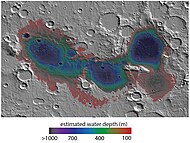
Map showing estimated water depth in different parts of Eridania Sea This map is about 530 miles across.
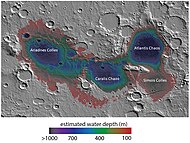
Features around Eridania Sea labeled
The region of this lake shows strong evidence for ancient magnetism on Mars.[61] It has been suggested that the crust was pulled apart here, as on plate boundaries on the Earth. There are high levels of potassium in the area which may point to a deep mantle source for volcanism or major changes in the crust.[62][63][64]
Later research with CRISM found thick deposits, greater than 400 meters thick, that contained the minerals saponite, talc-saponite, Fe-rich mica (for example, glauconite-nontronite), Fe- and Mg-serpentine, Mg-Fe-Ca-carbonate and probable Fe-sulphide. The Fe-sulphide probably formed in deep water from water heated by volcanoes. Analyses from the Mars Reconnaissance Orbiter provided evidence of ancient hydrothermal seafloor deposits in Eridania basin, suggesting that hydrothermal vents pumped mineral-laden water directly into this ancient Martian lake.[65][66]
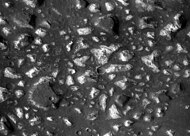
Deep-basin deposits from the floor of Eridania Sea. The mesas on the floor are there because they were protected against intense erosion by deep water/ice cover. CRISM measurements show minerals may be from seafloor hydrothermal deposits. Life may have originated in this sea.

Diagram showing how volcanic activity may have caused deposition of minerals on floor of Eridania Sea. Chlorides were deposited along the shoreline by evaporation.
Craters

Crater floor with the shape of an odd face, as seen by HiRISE under HiWish program. The box indicates where the next picture is located.

Close-up of a portion of a crater wall indicated in the previous photo. There seems to be grooves in the wall. Picture was taken with HiRISE under HiWish program.

Surface on crater floor, as seen by HiRISE under HiWish program.

Arrhenius Crater, as seen by CTX camera (on Mars Reconnaissance Orbiter).

Wells Crater, as seen by CTX camera (on Mars Reconnaissance Orbiter).
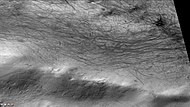
Dust devil tracks along rim of Wells Crater, as seen by CTX camera (on Mars Reconnaissance Orbiter). Note: this is an enlargement of previous image of Wells Crater.

West side of Rossby Crater, as seen by CTX camera (on Mars Reconnaissance Orbiter).

Gullies in Rossby Crater, as seen by CTX camera (on Mars Reconnaissance Orbiter). Note: this is an enlargement of previous image of west side of Rossby Crater.
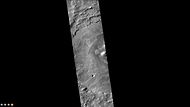
Martz Crater, as seen by CTXcamera (on Mars Reconnaissance Orbiter).

Gullies on central mound in Martz Crater, as seen by CTX camera (on Mars Reconnaissance Orbiter). Note: This is an enlargement of the previous image of Martz Crater.

Campbell Crater, as seen by CTX camera (on Mars Reconnaissance Orbiter).
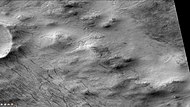
Dust devil tracks, as seen by CTX camera (on Mars Reconnaissance Orbiter). Note: this is an enlargement of the previous image of Campbell Crater.

Haldane Crater, as seen by CTX camera (on Mars Reconnaissance Orbiter). Dark portions on the floor are dunes.

Vinogradsky Crater, as seen by CTX camera (on Mars Reconnaissance Orbiter).

Priestly Crater, as seen by CTX camera (on Mars Reconnaissance Orbiter).
Latitude dependent mantle
Much of the Martian surface is covered with a thick ice-rich, mantle layer that has fallen from the sky a number of times in the past.[67][68][69] In some places a number of layers are visible in the mantle.[70] Some surfaces in Eridania are covered with this ice-rich mantling unit. In some places the surface displays a pitted or dissected texture; these textures are suggestive of material that once held ice that has since disappeared allowing the remaining soil to collapse into the subsurface.[71]

Mantle layers, as seen by HiRISE under HiWish program

Close view of places covered and not covered by mantle layer which falls from the sky when climate changes.

Wide view of crater with regions of latitude dependent mantle, as seen by HiRISE under HiWish program

Close view of crater with regions of latitude dependent mantle, as seen by HiRISE under HiWish program
Channels
There is enormous evidence that water once flowed in river valleys on Mars.[72][73] Images of curved channels have been seen in images from Mars spacecraft dating back to the early seventies with the Mariner 9 orbiter.[74][75][76][77] Indeed, a study published in June 2017, calculated that the volume of water needed to carve all the channels on Mars was even larger than the proposed ocean that the planet may have had. Water was probably recycled many times from the ocean to rainfall around Mars.[78][79]

Channel, as seen by HiRISE under HiWish program

Channel cutting across trough, as seen by HiRISE under HiWish program The trough and channel are labeled.

Channel on floor of crater, as seen by HiRISE under HiWish program

Channel, as seen by HiRISE under HiWish program

Channels, as seen by HiRISE under HiWish program

Channels, as seen by HiRISE under HiWish program

Channels, as seen by HiRISE under HiWish program

Channels, as seen by HiRISE under HiWish program

Channel, as seen by HiRISE under HiWish program

Channels, as seen by HiRISE under HiWish program These channels seem to disappear at time. They may be going under the ground for a time.

Channel on floor of a valley, as seen by HiRISE under HiWish program The small channel may have formed at some time after the larger valley; therefore, water may have been here more than once.
Other features in Eridania quadrangle
Map of Eridania quadrangle, with major craters.
Ariadne Colles Chaos, as seen by HiRISE. The original image displays many interesting details. The scale bar is 500 meters long.
Hummocks in Ariadness Colles, as seen by HiRISE. Right picture is an enlargement of a portion of the other picture.

Crater floor, as seen by HiRISE under HiWish program. Rough surface was produced by ice leaving the ground. The crater has accumulated much ice that is covered by rocks and dirt.

Crater floor showing brain terrain, as seen by HiRISE under HiWish program

Ridges exposed from under a dark layer, as seen by HiRISE under HiWish program

Layers, as seen by HiRISE under HiWish program
File:ESP 055104 1385pyramid.jpg|Layered featue in a crater, as seen by HiRISE under HiWish program
Other Mars quadrangles
Interactive Mars map
See also
- Barchan
- Dust devil tracks
- Eridania Lake
- Eridania Planitia
- Glaciers
- Glaciers on Mars
- HiRISE
- Latitude dependent mantle
- Lakes on Mars
- Martian Gullies
- MOC Public Targeting Program
References
^ Davies, M.E.; Batson, R.M.; Wu, S.S.C. “Geodesy and Cartography” in Kieffer, H.H.; Jakosky, B.M.; Snyder, C.W.; Matthews, M.S., Eds. Mars. University of Arizona Press: Tucson, 1992.
^ Grant, J. and P. Schultz. 1990. Gradational epochs on Mars: Evidence from west-northwest of Isidis Basin and Electric. Icarus: 84. 166-195.
^ Edgett, K. et al. 2003. Polar-and middle-latitude martian gullies: A view from MGS MOC after 2 Mars years in the mapping orbit. Lunar Planet. Sci. 34. Abstract 1038.
^ ab http://www.planetary.brown.edu/pdfs/3138.pdf
^ ab Dickson, J.; et al. (2007). "Martian gullies in the southern mid-latitudes of Mars Evidence for climate-controlled formation of young fluvial features based upon local and global topography". Icarus. 188: 315–323. Bibcode:2007Icar..188..315D. doi:10.1016/j.icarus.2006.11.020.CS1 maint: Explicit use of et al. (link) .mw-parser-output cite.citation{font-style:inherit}.mw-parser-output q{quotes:"""""""'""'"}.mw-parser-output code.cs1-code{color:inherit;background:inherit;border:inherit;padding:inherit}.mw-parser-output .cs1-lock-free a{background:url("//upload.wikimedia.org/wikipedia/commons/thumb/6/65/Lock-green.svg/9px-Lock-green.svg.png")no-repeat;background-position:right .1em center}.mw-parser-output .cs1-lock-limited a,.mw-parser-output .cs1-lock-registration a{background:url("//upload.wikimedia.org/wikipedia/commons/thumb/d/d6/Lock-gray-alt-2.svg/9px-Lock-gray-alt-2.svg.png")no-repeat;background-position:right .1em center}.mw-parser-output .cs1-lock-subscription a{background:url("//upload.wikimedia.org/wikipedia/commons/thumb/a/aa/Lock-red-alt-2.svg/9px-Lock-red-alt-2.svg.png")no-repeat;background-position:right .1em center}.mw-parser-output .cs1-subscription,.mw-parser-output .cs1-registration{color:#555}.mw-parser-output .cs1-subscription span,.mw-parser-output .cs1-registration span{border-bottom:1px dotted;cursor:help}.mw-parser-output .cs1-hidden-error{display:none;font-size:100%}.mw-parser-output .cs1-visible-error{font-size:100%}.mw-parser-output .cs1-subscription,.mw-parser-output .cs1-registration,.mw-parser-output .cs1-format{font-size:95%}.mw-parser-output .cs1-kern-left,.mw-parser-output .cs1-kern-wl-left{padding-left:0.2em}.mw-parser-output .cs1-kern-right,.mw-parser-output .cs1-kern-wl-right{padding-right:0.2em}
^ http://www.psrd.hawaii.edu/Aug03/MartianGullies.html
^ Heldmann, J.; Mellon, M. (2004). "Observations of martian gullies and constraints on potential formation mechanisms. 2004". Icarus. 168: 285–304. Bibcode:2004Icar..168..285H. doi:10.1016/j.icarus.2003.11.024.
^ Forget, F. et al. 2006. Planet Mars Story of Another World. Praxis Publishing. Chichester, UK.
^ Heldmann, J.; Mellon, M. (2004). "Observations of martian gullies and constraints on potential formation mechanisms". Icarus. 168: 285–304. Bibcode:2004Icar..168..285H. doi:10.1016/j.icarus.2003.11.024.
^ http://www.space.com/scienceastronomy/mars_aquifer_041112.html
^ Harris, A and E. Tuttle. 1990. Geology of National Parks. Kendall/Hunt Publishing Company. Dubuque, Iowa
^ Malin, M. and K. Edgett. 2001. Mars Global Surveyor Mars Orbiter Camera: Interplanetary cruise through primary mission. J. Geophys. Res.: 106, 23429-23570
^ Mustard, J. et al. 2001. Evidence for recent climate change on Mars from the identification of youthful near-surface ground ice. Nature 412. 411-414.
^ Carr, M (2001). "Mars Global Surveyor observations of fretted terrain". J. Geophys. Res. 106: 23571–23595. Bibcode:2001JGR...10623571C. doi:10.1029/2000je001316.
^ http://www.msnbc.msn.com/id/15702457?
^ Head, J. W. (2008). "Formation of gullies on Mars: Link to recent climate history and insolation microenvironments implicate surface water flow origin". Proceedings of the National Academy of Sciences. 105: 13258–13263. Bibcode:2008PNAS..10513258H. doi:10.1073/pnas.0803760105. PMC 2734344. PMID 18725636.
^ Head, J.; et al. (2008). "Formation of gullies on Mars: Link to recent climate history and insolation microenvironments implicate surface water flow origin". PNAS. 105: 13258–13263. Bibcode:2008PNAS..10513258H. doi:10.1073/pnas.0803760105. PMC 2734344. PMID 18725636.CS1 maint: Explicit use of et al. (link)
^ Christensen, P (2003). "Formation of recent martian gullies through melting of extensive water-rich snow deposits". Nature. 422: 45–48. Bibcode:2003Natur.422...45C. doi:10.1038/nature01436. PMID 12594459.
^ http://news.nationalgeographic.com/news/2008/03/080319-mars-gullies_2.html
^ Jakosky, B.; Carr, M. (1985). "Possible precipitation of ice at low latitudes of Mars during periods of high obliquity". Nature. 315: 559–561. Bibcode:1985Natur.315..559J. doi:10.1038/315559a0.
^ Jakosky, B.; et al. (1995). "Chaotic obliquity and the nature of the Martian climate". J. Geophys. Res. 100: 1579–1584. Bibcode:1995JGR...100.1579J. doi:10.1029/94je02801.CS1 maint: Explicit use of et al. (link)
^ MLA NASA/Jet Propulsion Laboratory (2003, December 18). Mars May Be Emerging From An Ice Age. ScienceDaily. Retrieved February 19, 2009, from http://www.sciencedaily.com /releases/2003/12/031218075443.htmAds by GoogleAdvertise
^ Hecht, M (2002). "Metastability of liquid water on Mars". Icarus. 156: 373–386. Bibcode:2002Icar..156..373H. doi:10.1006/icar.2001.6794.
^ Peulvast, J. Physio-Geo. 18. 87-105.
^ Costard, F. et al. 2001. Debris Flows on Mars: Analogy with Terrestrial Periglacial Environment and Climatic Implications. Lunar and Planetary Science XXXII (2001). 1534.pdf
^ http://www.spaceref.com:16090/news/viewpr.html?pid=7124[permanent dead link],
^ Clow, G (1987). "Generation of liquid water on Mars through the melting of a dusty snowpack". Icarus. 72: 95–127. Bibcode:1987Icar...72...95C. doi:10.1016/0019-1035(87)90123-0.
^ http://hirise.lpl.arizona.edu/PSP_00481_2410
^ http://marsrovers.jpl.nasa.gov/gallery/press/spirit/20070412a.html
^ "Archived copy". Archived from the original on 2011-10-28. Retrieved 2012-01-19.CS1 maint: Archived copy as title (link)
^ Reiss, D.; et al. (2011). "Multitemporal observations of identical active dust devils on Mars with High Resolution Stereo Camera (HRSC) and Mars Orbiter Camera (MOC)". Icarus. 215: 358–369. Bibcode:2011Icar..215..358R. doi:10.1016/j.icarus.2011.06.011.CS1 maint: Explicit use of et al. (link)
^ Barlow, N. 2008. Mars: An Introduction to its Interior, Surface and Atmosphere. Cambridge University Press
^
ISBN 978-0-387-48925-4
^
ISBN 978-0-521-82956-4
^ http://www.space.com/scienceastronomy/mars-plate-tectonics-recent-past-110103.html
^ Connerney, J. et al. 1999. Magnetic lineations in the ancient crust of Mars. Science: 284. 794-798.
^ Langlais, B. et al. 2004. Crustal magnetic field of Mars Journal of Geophysical Research 109: EO2008
^ Connerney, J.; et al. (2005). "Tectonic implications of Mars crustal magnetism". Proceedings of the National Academy of Sciences of the USA. 102: 14970–14975. Bibcode:2005PNAS..10214970C. doi:10.1073/pnas.0507469102. PMC 1250232. PMID 16217034.CS1 maint: Explicit use of et al. (link)
^ Acuna, M.; et al. (1999). "Global distribution of crustal magnetization discovered by the Mars Global Surveyor MAG/ER Experiment". Science. 284: 790–793. Bibcode:1999Sci...284..790A. doi:10.1126/science.284.5415.790.CS1 maint: Explicit use of et al. (link)
^ Baker, V., et al. 2017. THE WATERY ORIGIN AND EVOLUTION OF MARS: A GEOLOGICAL PERSPECTIVE. Lunar and Planetary Science XLVIII (2017). 3015.pdf
^ Baker, V. et al. 2004. TENTATIVE THEORIES FOR THE LONG-TERM GEOLOGICAL AND HYDROLOGICAL
EVOLUTION OF MARS. Lunar and Planetary Science XXXV (2004) 1399.pdf.
^ Baker, V., et al. 2002. A THEORY FOR THE GEOLOGICAL EVOLUTION OF MARS AND RELATED SYNTHESIS (GEOMARS). Lunar and Planetary Science XXXIII (2002). 1586pdf.
^ http://sci.esa.int/science-e/www/object/index.cfm?fobjectid=31028&fbodylongid=645
^ Pye, Kenneth; Haim Tsoar (2008). Aeolian Sand and Sand Dunes. Springer. p. 138. ISBN 9783540859109.
^ http://www.britannica.com/EBchecked/topic/53068/barchan
^ Mellon, J. T.; Feldman, W. C.; Prettyman, T. H. (2003). "The presence and stability of ground ice in the southern hemisphere of Mars". Icarus. 169 (2): 324–340. Bibcode:2004Icar..169..324M. doi:10.1016/j.icarus.2003.10.022.
^ ab "The Surface of Mars" Series: Cambridge Planetary Science (No. 6)
ISBN 978-0-511-26688-1 Michael H. Carr, United States Geological Survey, Menlo Park
^ Kieffer, H., et al. 1992. Mars. University of Arizona Press. Tucson.
ISBN 0-8165-1257-4
^ Milliken, R. E.; Mustard, J. F.; Goldsby, D. L. (2003). "Viscous flow features on the surface of Mars: Observations from high-resolution Mars Orbiter Camera (MOC) images". Journal of Geophysical Research. 108 (E6): 5057. Bibcode:2003JGRE..108.5057M. doi:10.1029/2002je002005.
^ Squyres, S.W.; Carr, M.H. (1986). "Geomorphic evidence for the distribution of ground ice on Mars". Science. 213: 249–253. Bibcode:1986Sci...231..249S. doi:10.1126/science.231.4735.249.
^ Head, J.W.; Marchant, D.R.; Dickson, J.L.; Kress, A.M. (2010). "Criteria for the recognition of debris-covered glacier and valley glacier landsystem deposits". Earth Planet. Sci. Lett. 294: 306–320. Bibcode:2010E&PSL.294..306H. doi:10.1016/j.epsl.2009.06.041.
^ Holt, J.W.; et al. (2008). "Radar sounding evidence for buried glaciers in the southern mid-latitudes of Mars". Science. 322: 1235–1238. Bibcode:2008Sci...322.1235H. doi:10.1126/science.1164246. PMID 19023078.CS1 maint: Explicit use of et al. (link)
^ Morgan, G.A.; Head, J.W.; Marchant, D.R. (2009). "Lineated valley fill (LVF) and lobate debris aprons (LDA) in the Deuteronilus Mensae northern dichotomy boundary region, Mars: Constraints on the extent, age and episodicity of Amazonian glacial events". Icarus. 202: 22–38. Bibcode:2009Icar..202...22M. doi:10.1016/j.icarus.2009.02.017.
^ Plaut, J.J.; Safaeinili, A.; Holt, J.W.; Phillips, R.J.; Head, J.W.; Sue, R.; Putzig, A. (2009). "Frigeri Radar evidence for ice in lobate debris aprons in the mid-northern latitudes of Mars". Geophys. Res. Lett. 36: L02203. Bibcode:2009GeoRL..36.2203P. doi:10.1029/2008gl036379.
^ Baker, D.M.H.; Head, J.W.; Marchant, D.R. (2010). "Flow patterns of lobate debris aprons and lineated valley fill north of Ismeniae Fossae, Mars: Evidence for extensive mid-latitude glaciation in the Late Amazonian". Icarus. 207: 186–209. Bibcode:2010Icar..207..186B. doi:10.1016/j.icarus.2009.11.017.
^ Arfstrom, J. (2005). "Terrestrial analogs and interrelationships". Icarus. 174: 321–335. Bibcode:2005Icar..174..321A. doi:10.1016/j.icarus.2004.05.026.
^ Irwin, R.; et al. (2004). "2004". J. Geophys. Res. 109: E12009. Bibcode:2004JGRE..10912009I. doi:10.1029/2004je002287.CS1 maint: Explicit use of et al. (link)
^ ab Michalski, J., E. Noe Dobrea1, C. Weitz. 2015. Mg-rich clays and silica-bearing deposits in Eridania basin: Possible evidence for ancient sea deposits in Mars. 46th Lunar and Planetary Science Conference. 2754.pdf
^ Baker, D., J. Head. 2014. 44th LPSC, abstract #1252
^ Cuadros, J.; et al. (2013). "Crystal-chemistry of interstratified Mg/Fe-clay minerals from seafloor hydrothermal sites". Chem. Geol. 360–361: 142–158. Bibcode:2013ChGeo.360..142C. doi:10.1016/j.chemgeo.2013.10.016.CS1 maint: Explicit use of et al. (link)
^ Connerney, J.; et al. (2005). "Tectonic implications of Mars crustal magnetism". Proc. Natl. Acad. Sci. USA. 102: 14970–14975. Bibcode:2005PNAS..10214970C. doi:10.1073/pnas.0507469102. PMC 1250232. PMID 16217034.CS1 maint: Explicit use of et al. (link)
^ Hahn, B.; et al. (2011). "Martian surface heat production and crustal heat flow from Mars Odyssey Gamma-Ray spectrometry". Geophys. Res. Lett. 38: L14203. Bibcode:2011GeoRL..3814203H. doi:10.1029/2011gl047435.CS1 maint: Explicit use of et al. (link)
^ Staudigel, H. 2013. Treatise on Geochemistry 2nd edn, Vol. 4 (eds Holland, H. & Turekian, K.), 583–606.
^ Taylor, G.; et al. (2006). "Variations in K/Th on Mars". J. Geophys. Res. 111: 1–20. Bibcode:2006JGRE..111.3S06T. doi:10.1029/2006JE002676.CS1 maint: Explicit use of et al. (link)
^ Mars Study Yields Clues to Possible Cradle of Life. NASA News, 6 October 2017.
^ Michalski, JR; Dobrea, EZN; Niles, PB; Cuadros, J (2017). "Ancient hydrothermal seafloor deposits in Eridania basin on Mars". Nat Commun. 8: 15978. Bibcode:2017NatCo...815978M. doi:10.1038/ncomms15978. PMC 5508135. PMID 28691699.
^ Hecht, M (2002). "Metastability of water on Mars". Icarus. 156: 373–386. Bibcode:2002Icar..156..373H. doi:10.1006/icar.2001.6794.
^ Mustard, J.; et al. (2001). "Evidence for recent climate change on Mars from the identification of youthful near-surface ground ice". Nature. 412 (6845): 411–414. doi:10.1038/35086515. PMID 11473309.CS1 maint: Explicit use of et al. (link)
^ Pollack, J.; Colburn, D.; Flaser, F.; Kahn, R.; Carson, C.; Pidek, D. (1979). "Properties and effects of dust suspended in the martian atmosphere". J. Geophys. Res. 84: 2929–2945. Bibcode:1979JGR....84.2929P. doi:10.1029/jb084ib06p02929.
^ http://www.uahirise.org/ESP_048897_2125
^ http://hirise.lpl.arizona.edu/PSP_006736_1325
^ Baker, V.; et al. (2015). "Fluvial geomorphology on Earth-like planetary surfaces: a review". Geomorphology. 245: 149–182. doi:10.1016/j.geomorph.2015.05.002.CS1 maint: Explicit use of et al. (link)
^ Carr, M. 1996. in Water on Mars. Oxford Univ. Press.
^ Baker, V. 1982. The Channels of Mars. Univ. of Tex. Press, Austin, TX
^ Baker, V.; Strom, R.; Gulick, V.; Kargel, J.; Komatsu, G.; Kale, V. (1991). "Ancient oceans, ice sheets and the hydrological cycle on Mars". Nature. 352: 589–594. Bibcode:1991Natur.352..589B. doi:10.1038/352589a0.
^ Carr, M (1979). "Formation of Martian flood features by release of water from confined aquifers". J. Geophys. Res. 84: 2995–300. Bibcode:1979JGR....84.2995C. doi:10.1029/jb084ib06p02995.
^ Komar, P (1979). "Comparisons of the hydraulics of water flows in Martian outflow channels with flows of similar scale on Earth". Icarus. 37: 156–181. Bibcode:1979Icar...37..156K. doi:10.1016/0019-1035(79)90123-4.
^ http://spaceref.com/mars/how-much-water-was-needed-to-carve-valleys-on-mars.html
^ Luo, W.; et al. (2017). "New Martian valley network volume estimate consistent with ancient ocean and warm and wet climate". Nature Communications. 8: 15766. Bibcode:2017NatCo...815766L. doi:10.1038/ncomms15766.CS1 maint: Explicit use of et al. (link)
^ Morton, Oliver (2002). Mapping Mars: Science, Imagination, and the Birth of a World. New York: Picador USA. p. 98. ISBN 0-312-24551-3.
^ "Online Atlas of Mars". Ralphaeschliman.com. Retrieved December 16, 2012.
^ "PIA03467: The MGS MOC Wide Angle Map of Mars". Photojournal. NASA / Jet Propulsion Laboratory. February 16, 2002. Retrieved December 16, 2012.
Further reading
- Lorenz, R. 2014. The Dune Whisperers. The Planetary Report: 34, 1, 8-14
- Lorenz, R., J. Zimbelman. 2014. Dune Worlds: How Windblown Sand Shapes Planetary Landscapes. Springer Praxis Books / Geophysical Sciences.
External links
| Wikimedia Commons has media related to Eridania quadrangle. |
- General review of many of the theories involving the origin of gullies.
- Good review of the history of the discovery of gullies.
- Martian Ice - Jim Secosky - 16th Annual International Mars Society Convention
Quadrangles on Mars | ||||||||||||||||||||||||||||||||||||||||||||||||||||||||||||||||||||||||||||||||||||||||||||||||||||||||||||||||||||||||||||||||||||||||||||||||
|---|---|---|---|---|---|---|---|---|---|---|---|---|---|---|---|---|---|---|---|---|---|---|---|---|---|---|---|---|---|---|---|---|---|---|---|---|---|---|---|---|---|---|---|---|---|---|---|---|---|---|---|---|---|---|---|---|---|---|---|---|---|---|---|---|---|---|---|---|---|---|---|---|---|---|---|---|---|---|---|---|---|---|---|---|---|---|---|---|---|---|---|---|---|---|---|---|---|---|---|---|---|---|---|---|---|---|---|---|---|---|---|---|---|---|---|---|---|---|---|---|---|---|---|---|---|---|---|---|---|---|---|---|---|---|---|---|---|---|---|---|---|---|---|---|
| ||||||||||||||||||||||||||||||||||||||||||||||||||||||||||||||||||||||||||||||||||||||||||||||||||||||||||||||||||||||||||||||||||||||||||||||||























